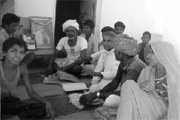Return of the woods
Return of the woods

the struggle against the British which finally ended in Independence plunged the villagers of Seed, Rajasthan, into troubled times. After over two decades of helpless suffering, it took a Gandhian from the neighbouring village of Sethwana to dispel the clouds of despondency. The simple step involved converting Seed to a gramdan village, thereby enabling the village elders to have total control over its resource management. That was 17 years ago. Today, Seed is a picture of abundance.
Situated 70 km from Udaipur, the village had once boasted a lush green habitat, high soil moisture, plenty of cattle in every home, sufficient food and impressive wildlife. But Independence brought doom. The village came under the manipulative fingers of corrupt government officials and was soon stripped of its trees. "Though we were hired as labourers in the timber trade, we were paid a measly sum,' recalls Devi Singh Rawat, adhyaksha of the village gram sabha . Worse still, the disappearing forest cover was followed by other disasters. There was hardly any water and the region experienced a spell of drought. "Desperation pushed the villagers, especially the youth, into anti-social activities,' says Ram Rawat, a villager.
Into this dismal scenario, stepped Rameshwar Prasad. Disturbed by the deterioration that had seeped into Seed, Prasad talked the village elders into considering a gramdan status for Seed, as a last resort if the environment and the village were to be saved. Once a village is registered under the unique Rajasthan Gramdan Act, 1971, its gram sabha is bestowed with executive and legal powers to manage all natural resources within the village boundary. The gram sabha also has the power to judge, penalise and prosecute offenders. The Act was inspired by Acharya Vinobha Bhave. Besides being a Gandhian, Prasad was motivated by the gramdan concept since his meeting with the Acharya in 1959.
Under Prasad's guidance, the village of Seed, along with four other neighbouring villages, adopted a resolution accepting gramdan status at an impressive ceremony in Udaipur. Irked by the proceedings, local government officials instigated trouble. "The tehsildar went to the extent of destroying all the necessary documents,' says Devi Rawat. But after persistent efforts, the village finally got official sanction in 1982.
Unlike a panchayat , where the village head is called the sarpanch , in a gramdan there is the village adhyaksha . In fact, the villagers in Seed take this difference in titles very seriously, and the adhyaksha does not hesitate to correct you if you address him as sarpanch . The adhyaksha enjoys a tenure of three years, after which the villagers nominate a new head.
Under the adhyaksha , there is a 13-member karya palika (executive committee), which includes two women. Then there is gram sabha , which comprises all adults in the village. A number of other committees have been set up to look into specific aspects like the nyaya samiti (justice committee), the gram kosh (responsible for the cash and grain bank) and the van suraksha samiti (forest management committee).
Protecting the land The gram sabha has devised clear rules for the protection of the village common lands which are divided into two categories







